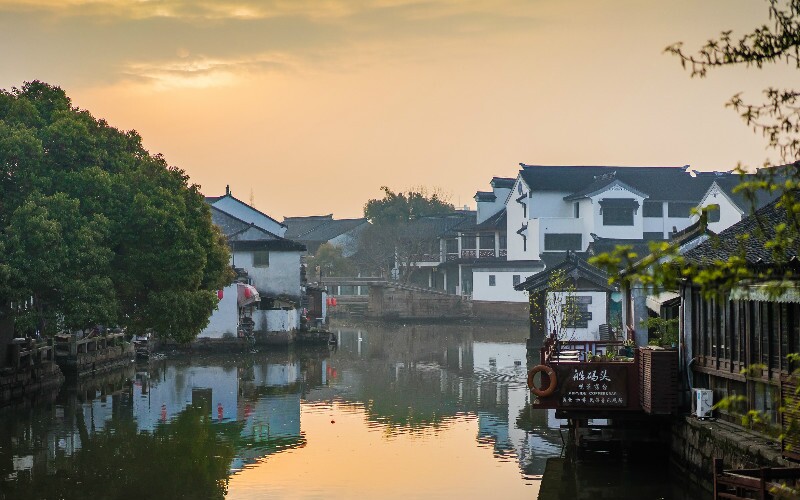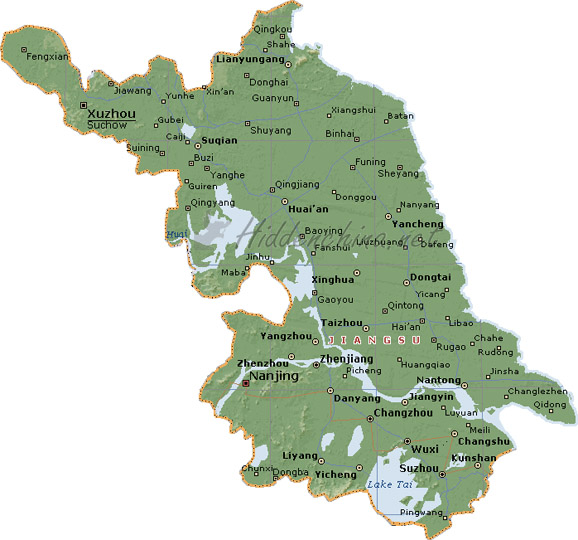Where is Jiangsu province?

Jiangsu is a provincial administrative region of the people’s Republic of China. The capital of Nanjing is located in the Yangtze River Delta area.
| Capital | Nanjing |
| Largest city | Suzhou |
| Divisions | 13 prefectures, 106 counties, 1488 townships |
| Government | Province |
| Area | 102,600 km2 (39,600 sq mi) |
| Highest elevation (Mount Yuntai) | 625 m (2,051 ft) |
| Population | 84,748,016 |
| Population Density | 830/km2 (2,100/sq mi) |
The eastern coast of the Chinese mainland is located at 30 degrees 45’to 35 degrees 08′, and 116 degrees 21’to 121 degrees 56′ east longitude, which is bordered by Shanghai, Zhejiang, Anhui, and Shandong provinces. Jiangsu is a coastal area across rivers, with many lakes and flat terrain.
The landform is composed of plains, waters, low mountains, and hills; It faces the Yellow Sea in the East and crosses the Yangtze River and Huaihe river systems.
Jiangsu geographically spans north and south, and its climate and vegetation have the characteristics of both South and North. Jiangsu covers a total area of 107,200 square kilometers. Jiangsu has a permanent resident population of 84,748,016.
Jiangsu is one of the birthplaces of ancient Chinese civilization. It has four multicultural and regional characteristics of “Wu”, “Jinling”, “Huaiyang” and “Central Plains”, with a total of 13 famous national historical and cultural cities.
Located in the Yangtze River economic belt, Jiangsu governs 13 districts and cities. It is the only province in China where all prefecture-level administrative regions are among the top 100. Jiangsu’s per capita GDP, regional development, and people’s livelihood index (DLI) rank first among provinces in China.
It has become one of the provinces with the highest comprehensive development level in China and has entered the level of “medium and high-grade” developed countries.
The comprehensive competitiveness of Jiangsu Province’s regional economy ranks first in the country, the actual scale of foreign investment ranks first in the country, and the per capita GDP has continuously and steadily ranked first in the country since 2009.
It is one of the most economically active provinces in China. The Yangtze River Delta urban agglomeration composed of Shanghai, Zhejiang, and Anhui has become one of the six world-class urban agglomerations.
Cities in Jiangsu province
| City | Urban area | District area |
| Nanjing | 5,827,888 | 7,165,292 |
| Nanjing (new districts) | 410,298 | 838,452 |
| Suzhou | 3,302,152 | 4,072,081 |
| Suzhou (new district) | 781,771 | 1,273,880 |
| Wuxi | 2,757,736 | 3,543,719 |
| Changzhou | 2,257,376 | 3,290,918 |
| Changzhou (new district) | 275,185 | 551,991 |
| Xuzhou | 1,735,166 | 1,967,214 |
| Xuzhou (new district) | 479,629 | 1,086,564 |
| Nantong | 1,612,385 | 2,274,113 |
| Huai’an | 1,523,655 | 2,635,406 |
| Huai’an (new district) | 146,359 | 326,459 |
| Yancheng | 1,136,826 | 1,615,836 |
| Yancheng (new district) | 347,389 | 706,662 |
| Kunshan | 1,118,617 | 1,644,860 |
| Yangzhou | 1,077,531 | 1,392,563 |
| Yangzhou (new district) | 506,706 | 1,006,372 |
| Jiangyin | 1,013,670 | 1,595,138 |
| Zhenjiang | 950,516 | 1,200,760 |
| Changshu | 929,124 | 1,510,453 |
| Lianyungang[h] | 897,393 | 1,050,523 |
| Lianyungang (new district) | 413,809 | 950,486 |
| Suqian | 783,376 | 1,437,685 |
| Zhangjiagang | 762,625 | 1,246,762 |
| Yixing | 710,497 | 1,235,542 |
| Taizhou | 676,877 | 878,463 |
| Taizhou (new district) | 376,724 | 728,645 |
| Pizhou | 631,572 | 1,458,038 |
| Rugao | 614,909 | 1,267,066 |
| Xinghua | 575,288 | 1,253,548 |
| Taixing | 553,079 | 1,073,921 |
| Danyang | 500,572 | 960,662 |
| Dongtai | 489,815 | 990,306 |
| Qidong | 479,243 | 972,525 |
| Haimen | 453,781 | 907,598 |
| Taicang | 435,225 | 711,854 |
| Hai’an | 424,900 | 866,337 |
| Xinyi | 402,169 | 920,628 |
| Jingjiang | 388,119 | 684,360 |
| Liyang | 368,409 | 749,522 |
| Gaoyou | 341,069 | 744,685 |
| Jurong | 299,033 | 617,706 |
| Yizheng | 271,969 | 564,021 |
| Yangzhong | 179,771 | 334,977 |
Jiangsu province map

People also ask about Shanxi province
Jiangsu is considered a province of elegance and beauty, the home of classical gardens, refined craftsmanship, and beautiful silks. Its importance as capital in both ancient and modern times has bestowed it with a bounty of cultural and historical heritage.
Jiangsu can be considered rich since it has a higher per capita GDP than Guangdong which is widely known as China’s wealthiest province.
Jiangsu cuisine flavor is umami, natural, mild, and lightly sweet with the rich original flavor of food materials. The dishes are served delicately like artworks.
